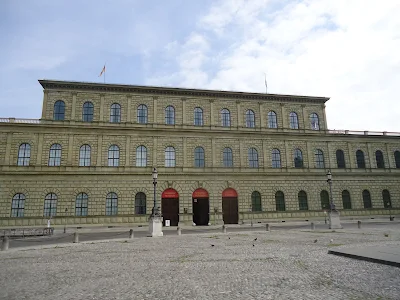One of the greatest palace surprises ever was the Residenz in Munich. As the proverb says: don't jugde a book by its cover, it also can apply to seemingly boring palaces. So don't jugde a palace by its facade.
Some Facts
The Residenz is the largest city palace in Germany and is today open to visitors for its architecture, room decorations, and displays from the former royal collections. The complex of buildings contains ten courtyards and displays 130 rooms.
own pictures of the Residenz taken in 2014
Some royal history
The first buildings at this site were erected in the year 1385 and were financed by the township of Munich as a sanction for a failed uprising against Stephen III (1375–1413) and his younger
brothers. The Silver Tower (Silberturm), as the strongest bastion, was significantly situated next to the inner walls protecting the castle against the city.
With the order of William IV (1508–1550) to expand the Neuveste with the so-called Rundstubenbau and to set up the first Court Garden, began the history of the Munich Residenz as a representative palace.
Source picture: Wikipedia
Under Albert V (1550–1579) Wilhelm Egkl built next to a banqueting hall of the Neuveste (St. George Hall) an art chamber in the building of the former ducal stables, many collections in Munich originate from there.
William V (1579–1597) ordered the construction of the Witwenstock (Widow Wing) for the dowager Duchess Anna and in 1581–1586 the four wings of the Grottenhof. Friedrich Sustris was the architect.
Around 1590 the construction of the Black Hall began to the southeast on the Antiquarium. Under direction of Sustris the Erbprinzentrakt (Prince Wing), north of the Witwenstock was added.
Maximilian I (1597–1651) commissioned what is now called the Maximilian Residenz (Maximilianische Residenz ), the west wing of the palace.
Until the 19th century, it was the only publicly visible facade and it still is preserved. The portals are guarded by two lions and a statue of the Virgin Mary as patroness of Bavaria in a wall niche between the portals on the west side of the residence complex. Maximilian had rebuilt and connected the existing buildings.
Its large dimensions satisfied Maximilian's successors up to 18th century, who contented themselves with interior upgrading and smaller extensions such as the wing for the Grüne Galerie (1730) and the Residenz Theatre (1751).
Today's building is from the time of King Ludwig I of Bavaria (1825–1848), who instructed his architect Leo von Klenze to extend the palace.
Between 1825 and 1835 the King's building (Königsbau) was constructed to the south in the style of the Florentine Palazzo Pitti. The building is 30 meters high.
In the Königsbau are numerous suites of rooms, including the State Apartment of Ludwig I on the first floor and the Nibelungen Halls on the ground floor.
Today also the Treasury is situated in the ground floor of the Königsbau. The royal living rooms are still preserved, they served primarily for the representation and could be visited by appointment already at that time.
The actual private apartments of the royal couple on the back of Königsbau have not survived due to its destruction in World War II.
On the second floor were the so-called Festgemächer, which were intended for minor court festivities. The spatial sequence was divided into lounge, reception salon, dance hall, flowers hall and private rooms for the king. These rooms are still preserved but in a highly simplified form and are now home to the Bavarian Academy of Fine Arts.






Nowadays
The Munich Residence and its museums have received more than 300,000 visitors per year, similar to the Nymphenburg Palace and ahead of Schleissheim Palace, but clearly behind the castles of
King Ludwig II, especially Neuschwanstein. However it's really a visit worth!
💥
I took the pictures of the Munich Residenz outside and inside during a visit in 2014. The pictures from the royals are from Wikipedia.
💥
👉 More about the former royal family of Bavaria on this link
👉 More about the royal families in Germany on this link


















Comments